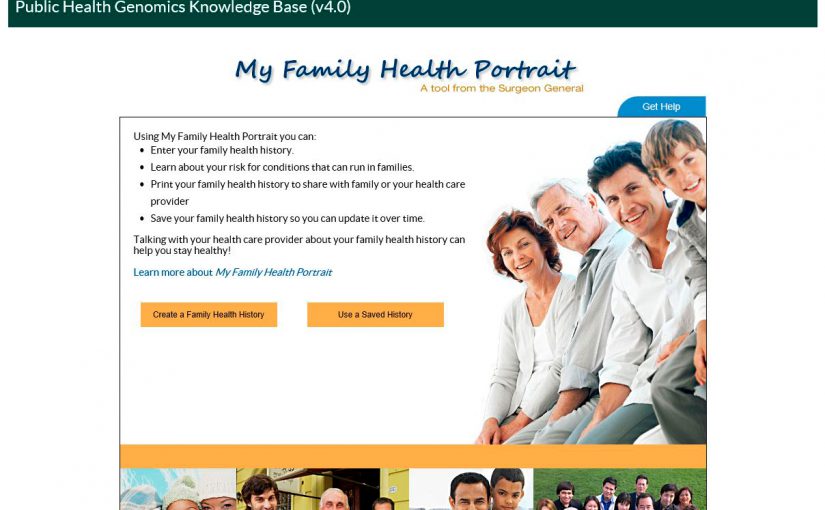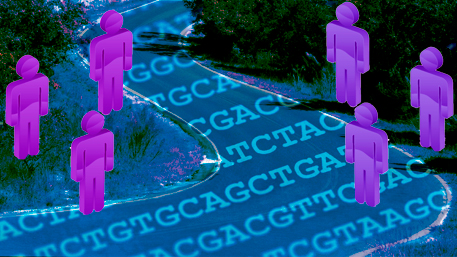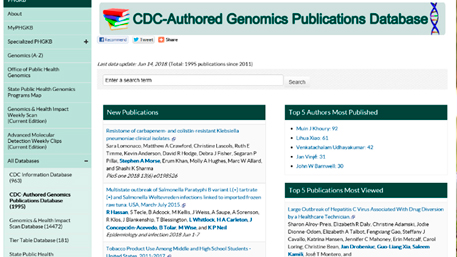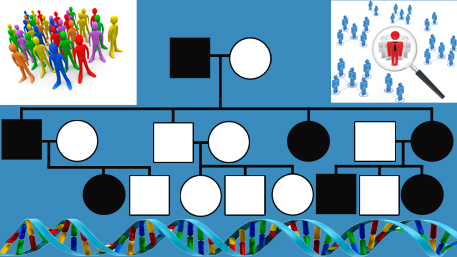Search Results
10 results for cancer
The Road Less Traveled: Genomic Epidemiology Capacity in State Public Health Programs

In 2017, the Council of State and Territorial Epidemiologists (CSTE) published its latest Epidemiology Capacity Assessment of state health departments’ workforce size and resources. The assessment inquired about the number of current and optimal epidemiologist positions; sources of epidemiology activity and funding; and states’ self-perceived capacity to lead epidemiology activities, provide expertise, and manage resources
Posted on byAnnouncing a New CDC Home for the U.S. Surgeon General’s Family Health History Tool

On Thanksgiving Day 2004, the U.S. Surgeon General launched a national public health campaign called the U.S. Surgeon General’s Family History Initiative. The campaign quickly became a yearly event to raise public awareness about the importance of family health history, and encourage all families to learn more about their health histories. The initiative also launched
Posted on byWhat is the Value of Rapid Genomic Sequencing in Acute Infant Care?

Rapid genomic sequencing includes both rapid genome sequencing (rGS) and rapid exome sequencing (rES). Proponents argue that next generation sequencing (NGS) in acutely ill infants can deliver timely diagnostic results and enable life-changing clinical interventions. An international group of experts recently published a white paper in Genetics in Medicine that made the following assertions: Demonstration
Posted on by 1 CommentA Road Map for Evaluation and Appropriate Implementation of Genome Sequencing to Improve Population Health

This blog is a summary of our recently published paper in PLOS Medicine, and is an update of my 2011 blog on “binning” the human genome. A common vision for genomic medicine is that genome sequencing will be routinely used in health systems to provide health care and preventive services tailored to each individual. For
Posted on byTracking Progress in Public Health Genomics at CDC: A New CDC-Authored Genomics Publication Database

Are you curious about the progress CDC is making in genomic research? With the ever-increasing amount of scientific literature on genomics in public health—from infectious diseases to chronic diseases and environmental health—a new database offers timely updates on genomic research by CDC staff. The CDC’s Office of Public Health Genomics, has launched a new CDC-Authored
Posted on byCan Genetic Risk Scores Score a Win for Precision Prevention? Time and Rigorous Studies Will Tell

In May 2018, CDC’s Office of Public Health Genomics, the National Cancer Institute’s Division of Cancer Control and Population Sciences, and the National Heart, Lung, and Blood Institute’s Center for Translation Research and Implementation Science held a special webinar titled: “Using Genetic Risk Scores in the Prevention and Control of Common Diseases: Opportunities and Challenges.”
Posted on byStimulating Implementation Science in Genomics and Precision Medicine for Heart, Lung, Blood and Sleep Diseases: The Case of Familial Hypercholesterolemia

Implementation science is an emerging field of scientific inquiry that has been increasingly applied to genomics and precision medicine. In our recent papers on the state of scientific publications and NIH funding, we have identified areas of growth and limitations of the field and called for more training and workforce development for implementation science in
Posted on byPrecision Medicine in Action: How well does cascade screening for hereditary conditions work in the real world?

An important component of precision medicine is the identification, through genetic testing, of people who are at elevated risk of disease because of pathogenic germline mutations. Cascade screening involves contacting relatives of patients with certain hereditary conditions to help inform, manage, and identify those who may be at increased risk. A systematic scoping review on
Posted on byTracking the Translation of Genomic Discoveries to Population Health Benefits: Connecting the Dots from Investment to Population Health Information

In March 2018, the CDC Office of Public Health Genomics launched the Grant Database (GDB), an extension of the Public Health Genomics Knowledge Base (PHGKB). GDB “connects the dots” between funding investment and publications on translation, implementation, and evaluation of population health impact of genomics and precision medicine. We launched PHGKB in 2016, as an
Posted on byGenomics and Population Health Action: The Collaboration Continues!

In March 2018, I attended the third annual meeting of leaders of the Genomics and Population Health Action Collaborative (GPHAC). GPHAC was formed late in 2015 under the auspices of the National Academy of Medicine’s Roundtable on Genomics and Precision Health to foster collaboration of more than 50 diverse stakeholders, including state public health programs,
Posted on by

